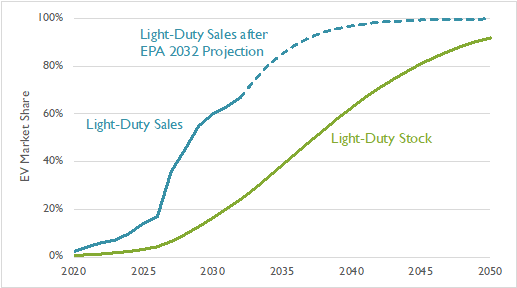EPA to Provide a Big Push in the EV Revolution

After the federal Inflation Reduction Act (IRA) provided numerous incentives to decarbonize the transportation sector, the U.S. Environmental Protection Agency (EPA) backed up that effort with a proposed rule for more stringent vehicle emissions standards. Using Synapse’s EV-REDI tool and EPA’s estimates of the effects of its regulation, we calculated the expected emissions benefits of the proposed rule. The near-term benefits will be substantial, and those that accrue over the long term make this regulatory change both a no-brainer and an essential step forward if the United States wishes to meet its commitments to fighting climate change.
The transportation sector is now the largest contributor to greenhouse gas emissions in the United States. While more efficient vehicles have nudged emissions down over the past two decades, it hasn’t been enough. The congressional budget office recently concluded that “reducing emissions from transportation has been difficult because of the value that people place on transportation and the dominance of a single fuel source—petroleum.”
How will the proposed rule affect EVs?
The EPA’s proposed rule will help shift that paradigm more quickly than “business as usual.” It will accelerate a trend evident in the recent surge in EV sales and skyrocketing post-IRA automaker investments in EV manufacturing capacity. For example, GM is planning to build 1 million EVs in North America by 2025 after selling just 40,000 EVs in the US in 2022. Focusing here on the light-duty portion of the rule, it will substantially strengthen tailpipe emissions standards for new vehicle sales and put the sector on a much lower-emitting trajectory.
The EPA estimates the proposal would help to increase new sales of light-duty battery electric vehicles from around 6 percent of all new light-duty vehicle sales today to 67 percent by 2032. Our modeling suggests EVs would, by this time, comprise 24 percent of total light-duty vehicles on the road. The increase in EV deployment, along with fuel efficiency improvements among the remaining gas-powered vehicles, would result in a modeled 36 percent reduction in light-duty emissions. For comparison, from 2005 to 2021 emissions from transportation sector went down just 6 percent.


As seen above, these benefits increase as the existing stock of light-duty vehicles retires and EV sales continue towards 100 percent of new vehicles sold. Targeting emissions reductions in new vehicles as quickly as possible is essential to avoid locking in emissions from new cars and trucks that will last on the roads and pollute for decades. And since new vehicles are largely purchased by wealthier households, the proposal limits cost impacts to lower income families.
We note that total emissions from the transportation sector in an electrified world will depend on the emissions intensity of electricity where (and when) vehicles are charged. As the electric grid becomes cleaner—a process that is well underway thanks to the falling costs of renewables, state-level policy, and subsidies provided in the Inflation Reduction Act—so too will transportation sector emissions.
What about public transit?
Let’s not forget that driving alone, everywhere and all the time, is not the only option. The EV revolution must be complemented by a revolution in public transit (including electric buses), housing built near jobs, and even walking and biking. The Biden administration seems to get it, and local governments can help not only by supporting EVs but also by supporting non-car alternatives.
EPA's proposal is a critical step.
The EPA’s proposal will help to create regulatory certainty and shows the federal government’s commitment to transitioning our economy to clean alternatives. The rule leverages the IRA’s transformative investments into the EV revolution to achieve rapid and essential emissions reductions: with the IRA funding available, EPA could be more aggressive with emission reduction targets. If adopted, EPA’s proposal will be a critical step on the long road ahead to mitigate climate change and reduce pollution in our communities.